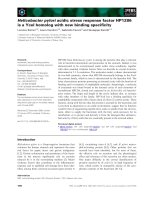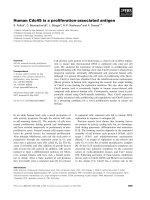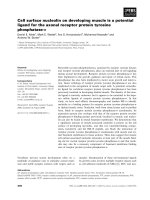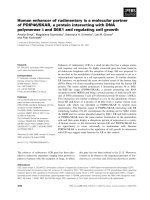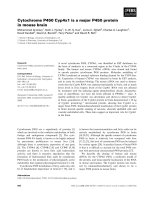individual assignment samsung is a south korean
Bạn đang xem bản rút gọn của tài liệu. Xem và tải ngay bản đầy đủ của tài liệu tại đây (3.65 MB, 25 trang )
<span class="text_page_counter">Trang 1</span><div class="page_container" data-page="1">
<b>Full name : Trương Bình DươngClass : MKT1608</b>
<b>Student ID: HE163114</b>
<b>Lecturer : Bùi Thị Hạnh ThảoCourse : Marketing PrinciplesDate : Summer 2021</b>
</div><span class="text_page_counter">Trang 2</span><div class="page_container" data-page="2"><b>TABLE OF CONTENTS I. INTRODUCTION.</b>
1. Company 3
2. Target customers 4
3. Products 5
<b> II. MICROENVIRONMENT.</b>
1. The company 6
2. Suppliers 9
3. Marketing Intermediaries 9
4. Competitors 10
5. Publics 11
6. Customer 11
<b> III. MACROENVIROMENT.</b>
1. The demographic 12
2. The economic 14
3. The natural 15
4. The technology 15
</div><span class="text_page_counter">Trang 3</span><div class="page_container" data-page="3">5. The political and social 16
6. The culture 17
</div><span class="text_page_counter">Trang 4</span><div class="page_container" data-page="4">Image 1
The current chairman Lee Kun-Hee laid the foundations for today’s Samsung when he tookover management in 1993. His declaration of new management principles emphasizedintellectual capital, organizational creativity, technological innovation and employeeempowerment. Samsung Electronics is one such key business unit that produces world-classmobile handsets, wide-screen plasma television screens, digital camcorders and otherhousehold appliances. Established in 1969, it was generating an operating profit of USD 27.2billion by 2012 (Martin Roll,2017)[3].
Samsung’s corporate vision is to “<i><b>Inspire the world with our innovative technologies,products and design that enrich people’s lives and contribute to social prosperity bycreating a new future.</b></i>” The company follows this vision statement to maintain profitabletechnology business operations that contribute to the improvement of people’s lives.(Victoria2018)[4].
Samsung’s mission statement is “<i><b>We will devote our human resources and technology tocreate superior products and services, thereby contributing to a better global society.</b></i>” Thiscorporate mission was published in the 1990s, when the company was undergoing rapidglobal expansion in various semiconductors, electronics, and related technology markets.(Victoria 2018)[5].
2. Target customer.
● Samsung’s targets a very wide range of consumers ranging from normal day to day usage devices to industrial standard equipment. The usual target age group of customers range from the 20s to 50s or even older, as long as the person has the
</div><span class="text_page_counter">Trang 5</span><div class="page_container" data-page="5">ability to purchase and use the products that Samsung has to offer in the market.(Essay Sauce 2019)[6].
● The campaign targeted Vietnamese young adults, aged 18 to 35, who belonged to middle-to-high social classes. Their lives are driven by modern fashion and trends; among them is a fascination for celebrities and love stories. Connectivity is an integralpart of their lives. The phone they use defines who they are and expresses how they want to be treated and perceived by others. Most of them consider the iPhone a preferable choice to Samsung.(casestudyhub)[7]
<i><b>making phones.(kores expose,2017)[8]</b></i>
● Samsung Electronics, the largest subsidiary, makes a huge range of products ranging from consumer electronics such as TVs, tablets, smartwatches, virtual reality headsets, home theater and audio, desktop computers, laptops, monitors, printers, memory devices, home appliances and security/monitoring systems, to semiconductorand memory parts.
Other major subsidiaries and their key products are as follows:● Samsung Heavy Industries
</div><span class="text_page_counter">Trang 6</span><div class="page_container" data-page="6">Ships, particularly, specialised vessels for use in the oil and gas industry; wind turbines
Displays for mobile devices, TVs and other products● Samsung Biologics
Bio-healthcare products● Samsung Bioepis
Biosimilars● Samsung Medison
Ultrasound devices and other medical equipment● Renault-Samsung
Originally Samsung Motors, but acquired by Renault Group from the Samsung Groupin 2000. But the latter retains a minority stake of about 20 percent in Renault-Samsung, and allows the use of the Samsung name by Renault as part of an agreement.
(korea expose,2017)[9]
Image3. The products of Samsung
5II. MICROENVIRONMENT.
1.Company.1.1 Top Managers.
</div><span class="text_page_counter">Trang 7</span><div class="page_container" data-page="7">● Samsung was founded as a grocery trading store on March 1, 1938, by Lee Chull. He started his business in Taegu, Korea, trading noodles and other goods produced in and around the city and exporting them to China and its provinces. After the Korean War, Lee expanded his business into textiles and opened the largest woolen mill in Korea. He focused heavily on industrialization with the goal of helpinghis country redevelop itself after the war. During that period his business benefited from the new protectionist policies adopted by the Korean government, whose aim was to help large domestic conglomerates chaebol ( ) by shielding them from competition and providing them easy financing.(Peter 2021)[10]
Byung-● CEO Samsung - since 2018, it has adopted a three-CEO layout. Currently, the three co-CEOs of Samsung Electronics are Kim Ki-nam, Kim Hyun-suk and Koh Dong-jin.(sam mobile 2021)[11]
● In Vietnam, Kevin Lee has officially been appointed as the General Director of Samsung Vina Electronics.With over 30 years of experience, Kevin Lee has held many senior leadership positions of Samsung in markets around the world. He used tobe Senior Vice President in charge of Verizon Partners and Samsung Electronics USA;General Manager of Samsung Electronics Benelux and Greece before becoming General Manager of Samsung Vina Electronics Company.(Rosy 2021)[12]
The semiconductor business saw an earnings decline quarter-on-quarter (QoQ) despite solid memory shipments, mainly due to the production disruption at the Austin fab, and a downward trend in NAND prices, while initial costs of new line ramp-up associated with advanced node migration also weighed on the results. Profit from the Display Panel Business fell quarter-on-quarter because of weak seasonality of mobile products.
Earnings at the Mobile Communications Business rose significantly as sales of flagship and mass-market smartphones increased and contributions of products in the Device Ecosystem such as tablets, PCs and wearables grew. The Networks Business maintained solid performance on the back of continued expansion of 5G globally.
The Consumer Electronics Division reported higher profit both quarter-on-quarter and on-year as demand remained strong for digital appliances and premium TVs.
<small>year-[KRW billion]Q1'21Q1'20YoY ChangeRevenues260.8207.2+53.6Operating Profit74.362.6+11.7</small>
<small>EBIT79.847.9+31.9Net Income61.036.8+24.2</small>
6
</div><span class="text_page_counter">Trang 8</span><div class="page_container" data-page="8">● According to the report on aggregate results, analysis of the 2019 financial statements of foreign-invested enterprises (FDI) has just been reported to the Prime Minister by the Ministry of Finance, 2 Samsung Group’s factories located in Vietnam include SEVBac Ninh and SEV Thai Nguyen are the two largest enterprises among 967 FDI enterprises in the group of Electronic components, computers and computer peripherals, and optical equipment operating in Vietnam.
● In which, the revenue of these 2 enterprises accounts for 48% of the total revenue of the whole industry group.
● Specifically, by the end of 2019, Samsung Electronics Vietnam Co., Ltd. (SEV Bac Ninh) has total assets of VND 247,008 billion, up 3.7% compared to 2018 earlier. Of these, the enterprise’s liabilities are 27,849 billion and all are short-term debts, the company has no long-term debts.
(vnexploer 2020)[14]
Image4
</div><span class="text_page_counter">Trang 9</span><div class="page_container" data-page="9">1.3 R&D (research and development).
● Samsung Research is the advanced research and development (R&D) hub of Samsung’s Consumer Electronics (CE) Division and IT & Mobile Communications (IM) Division. Samsung Research leads the development of the future technologies with more than 10,000 researchers and developers working in overseas R&D centers.● Under the vision of “Shape the Future with Innovation and Intelligence”, it is actively
conducting research and development (R&D) to identify new future growth areas and secure advanced technologies for its products & services to create new value and improve people’s lives.
● Core research themes at Samsung Research include artificial intelligence (AI), data intelligence, next-generation communications, robot, Tizen, life care & new experiences, next-generation media, and security. In particular, it is expanding its research scope to new promising fields to realize a new lifestyle based on AI technologies.
● The hub is working in collaboration with 14 overseas R&D centers in 12 countries worldwide and 7 global AI centers to secure innovative technologies and enhance its global R&D capacity. It is equally maximizing technological cooperation through active open innovation with distinguished universities, research institutes, and partner companies globally that have the world’s best technologies.● Samsung Research promises to continue working hard to become a global top
research institute that creates new values for the future through ceaseless innovation and intelligence.
(SAMSUNG 2021)[15]
8
</div><span class="text_page_counter">Trang 10</span><div class="page_container" data-page="10">managed operation management .As Manager Operation; they manage the control quality andquantity of purchase, storage, logistics and evaluation. Management of the operation depends on products and services. It is the combination of management services and products.Strategic management is the combination of decision and action direction which determines the long range performance of employers. Management operation is most important for each enterprise and it determines the success of the company. After the analysis any company mustmake a separate and unique operation strategic company. They know that competition in all national and international markets appeared again challenge of markets and the new phase. Whenever the business performance, company brands and quality products are becoming more important for customers and consumer price and product, the product development and strategic promotion is the essence of the competitive advantage.(UKessay 2015) [16]
2. Suppliers.
● Samsung’s supplier network has 2,500 suppliers (mainly first-tier suppliers) from around the world. These are the suppliers who provide raw materials, product components as well as equipment. The number of first-tier suppliers of Samsung in 2018 was 2,389.
● A large part of Samsung’s supplier network is located in countries including the US, China, Japan, Korea, Taiwan, Hongkong, and Vietnam as well as the UK. The US, China, Korea, Japan, and Taiwan, as well as Vietnam, are among the leading countrieswhere Samsung’s suppliers are located. China is the leading supplying country for a large number of big brands including the leading rivals of Samsung like Apple and Huawei and several more technology businesses.
● Here is a list of 26 Samsung suppliers whose names the company has revealed in the supplier section of its website:
AAC Technologies Holdings Inc China & Vietnam
Japan.Air Products and Chemicals
Alps Electric Co. ltd.Japan & Korea.
</div><span class="text_page_counter">Trang 11</span><div class="page_container" data-page="11">KoreaASM International N.V.USA & Korea
Biel Crystal Manufactory ltd.HongkongBOE Technology Group
company ltd.
Bujeon Electronics Co. ltd.Vietnam
Daeduck Electronics Co. ltd. KoreaDaeyoung Electronics Co. ltdVietnam
DongjinSemichem Co. ltd. KoreaDongwoo Finechem Co. ltd.Korea
</div><span class="text_page_counter">Trang 12</span><div class="page_container" data-page="12">(Abhijeet 2020)[17]
3. Marketing Intermediaries.
Marketing intermediaries help the Samsung Company to promote, sell and distribute its goods to final consumers or buyers. These include wholesalers and retailers. Wholesalers such as Tesco purchases large quantities of products from Samsung and store them in a warehouse and then sells smaller quantities to retailers. The retailers will purchases smaller quantities of goods from wholesalers or directly from Samsung Company. Retailers will storethe goods at a store and resells them to individual consumers.(UKessay 2015)[18]
4. Competitors.
● The top 10 Samsung competitors are: Apple, LG Electronics, Sony, HTC, Huawei Technologies, Intel, Electrolux, Lenovo Group Limited, Panasonic Corporation, and Whirlpool. Their total revenue for 2019 was $743.16 billion. Cumulatively, they had atotal of 1,060,443 employees. Apple is Samsung’s biggest competitor.
● The growing smartphone market has soared globally and Vietnam smartphoneconsumer market has been growing at a pace of 10% per year. In just 2017, Vietnamsold more than 15 million smartphones to become the largest market formanufacturers. Local buyers are, however, selective of their choices and big brandslike Sony and Nokia remain the least popular among Southeast Asian countries.Samsung, having a long establishment in the country, dominates almost half ofVietnam’s smartphone market. As the market expands, local Vietnamese companieswill compete in the market with lower-priced models. Vietnam’s competition ofsmartphone production has only just began.
Samsung dominates the smartphone market with 46.5% of shares, with China’s Oppofollowing at 19.4% and Apple at 9.2%. Oppo ventured into the Vietnamese market in2012 with specialized selfie functions and surpassed Apple within 5 years to becomeVietnam’s second largest smartphone provider. Xiaomi, a Chinese manufacturer, ispartnering with Vietnam’s consumer electronic retailer Digiworld to expand its marketpresence.
(technews 2018)[20]
</div><span class="text_page_counter">Trang 13</span><div class="page_container" data-page="13">6. Customer.
</div><span class="text_page_counter">Trang 14</span><div class="page_container" data-page="14">Samsung’s target audience are people from age 15 to 45 who follow the latest technology trends. Their lifestyles are driven by heavy consumption of TV and digital media, and they are especially engaged in local TV series, as well as celebrities and their aspirational lifestyles. This loyal group even takes to social media and hashtags to help move up the social ratings of their favorite shows. According to Nielsen research, this group prefers online channels for connecting with friends and often utilizes multiple screens when watching their programs.(casestudyhub )[22]
III. MACROENVIROMENT. 1. The demographic.
Vietnam is known for low-cost labor which is much cheaper than China. In 2016, it isestimated that the average wage of a Chinese employee was about 6 times higher than that ofa Vietnamese employee. Furthermore, Vietnamese labors fame of being hardworking andcreative also contributes to the success of MNEs operating in this country. Beside theavailability of cheap and good quality labor pool, proximity to China also makes Vietnammore attractive in the eyes of foreign investors. Previously, MNEs flocked into China to takeadvantage of the low-cost labors. Now, with the development of the economy, it is becomingcostlier to operate in China and MNEs take the trend to invest in China’s neighboringcountries as it is much easier and cheaper to move the production.
Moreover, improvement in infrastructure is another key factor facilitating the shift of MNEsto Vietnam. According to the (World Bank 2006)[23], around 9 - 10% of GDP has been usedfor investment in transport, telecommunications, energy, water, and sanitation. “The roadnetwork has more than doubled in length since 1990, and its quality has improvedsubstantially… The number of fixed and mobile phones per 100 people has multiplied nine-fold since 1995.” (World Bank, 2006). By 2020, Vietnam's Ministry of Transport is going tomake investment of over $5 billion to improve the countrys road transport infrastructure.Besides, one of the future strategies of infrastructure investment is to increase urbanpopulation, which will make it easier to do business in Vietnam when the costs ofinfrastructure provision are reduced through economies of scale.
</div>


